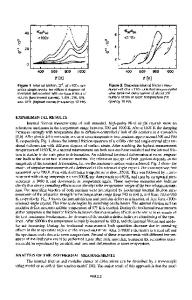Internal Friction and Dynamic Modulus in High Temperature Ru-Nb Shape Memory Intermetallics
- PDF / 274,132 Bytes
- 6 Pages / 432 x 648 pts Page_size
- 38 Downloads / 362 Views
Internal Friction and Dynamic Modulus in High Temperature Ru-Nb Shape Memory Intermetallics Laura Dirand1, Maria L. Nó1, Karine Chastaing2, Anne Denquin2, Jose San Juan3 1 Dpt. Física Aplicada II, Facultad de Ciencia y Tecnología, Universidad del País Vasco, Apdo. 644, 48080 Bilbao, Spain. 2 ONERA (DMMP), 29 avenue de la Division Leclerc, F-92322 Châtillon Cedex, France. 3 Dpt. Física Materia Condensada, Facultad de Ciencia y Tecnología, Universidad del País Vasco, Apdo. 644, 48080 Bilbao, Spain.
ABSTRACT Nowadays, aeronautic and aerospace are the more demanding sectors for shape memory alloys (SMA) after the bio-medical one. In particular the interest has been recently focused on very high temperature SMA, which would be able of working as sensors and actuators in the hot areas of the engines and exaust devices. In the present work we undertook a study of the Ru-Nb SMA Intermetallics, which undergo two succesive martensitic transformations around 1050 K and 1180 K respectively, depending on composition. This study has been focused on measurements of internal friction spectra and dynamic modulus variation up to 1700 K, which have been carried out in a sub-resonant torsion mechanical spectrometer. The internal friction and dynamic modulus have been studied as a function of the heatingcooling rate and the frequency in order to compare experimental behaviour with theoretical models for martensitic transformations. In addition to the internal friction peaks linked to both martensitic transformations we have also observed a complex relaxation process around 950 K, which seems to be linked to the interaction of the martensite interfaces with structural defects. An analysis and discusion of the potential microscopic mechanisms are also presented. INTRODUCTION Shape memory alloys (SMA) are functional intermetallics that can perform both sensing and actuating functions thanks to a reversible first order phase transition characterized mainly by an atomic shearing of the lattice planes from the high temperature and high symmetry phase, called Austenite, to the low temperature and lower symmetry phase called Martensite. In SMA the transition between both phases can be induced thermally or by the application of a stress promoting crystallographic shearing during the transformation, and consequently the shape memory and superelastic properties are controlled by the behavior of this thermo-elastic martensitic transformation (MT). See the textbooks [1, 2] for a general overview. The most developed and commercially distributed SMA is binary Ti-Ni, which unfortunately has his transformation temperatures limited to below 100ºC. However there are many potential applications requiring high temperature SMA (HT-SMA) and several families of materials have been developed with transformation temperatures between 100ºC and 600ºC, as recently reviewed by Ma et al. [3]. Nevertheless there are very few potential candidates to fulfill the requirements to be used above 600ºC, in hot areas of aero-engines and aerospace devices, which constitutes a
Data Loading...










